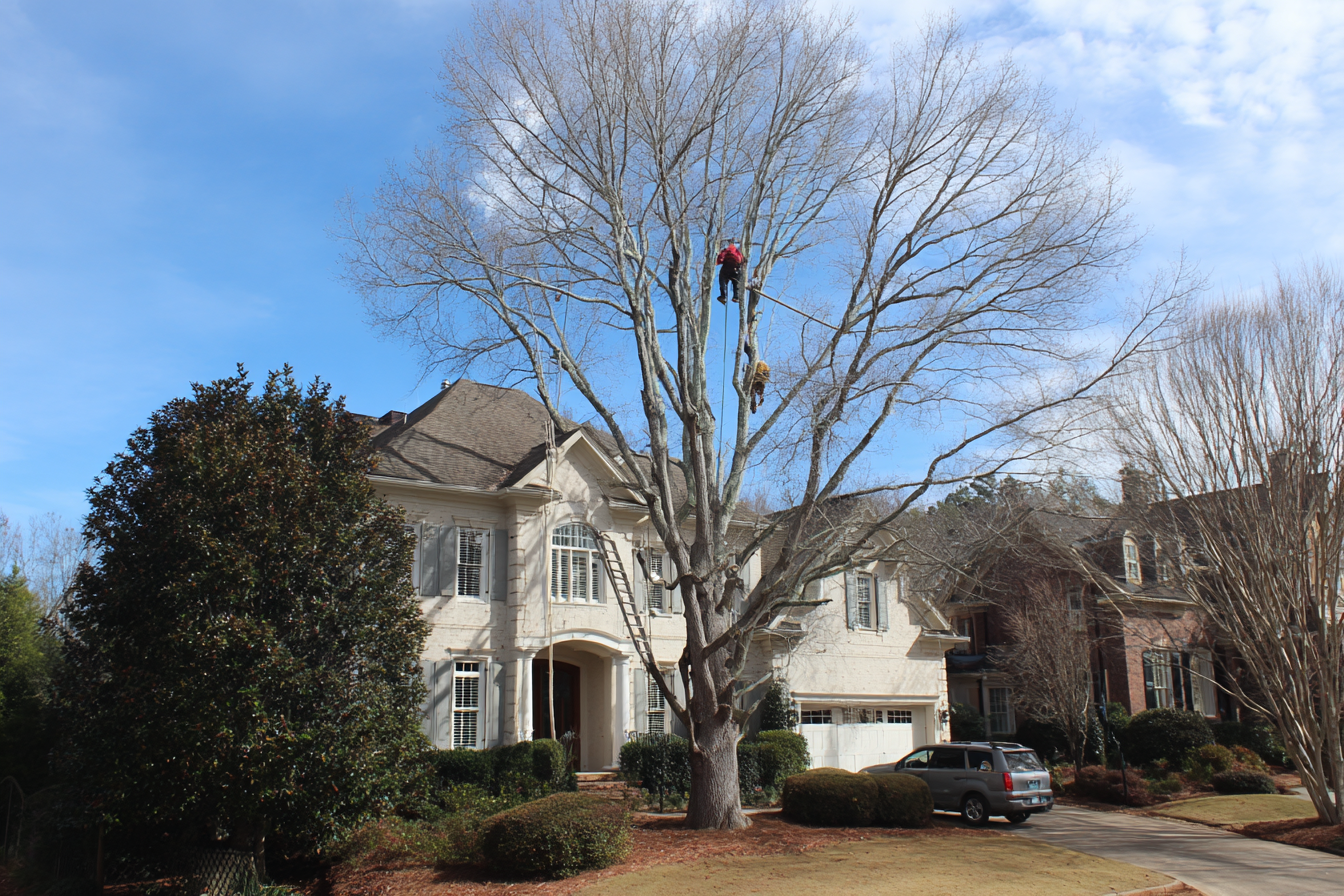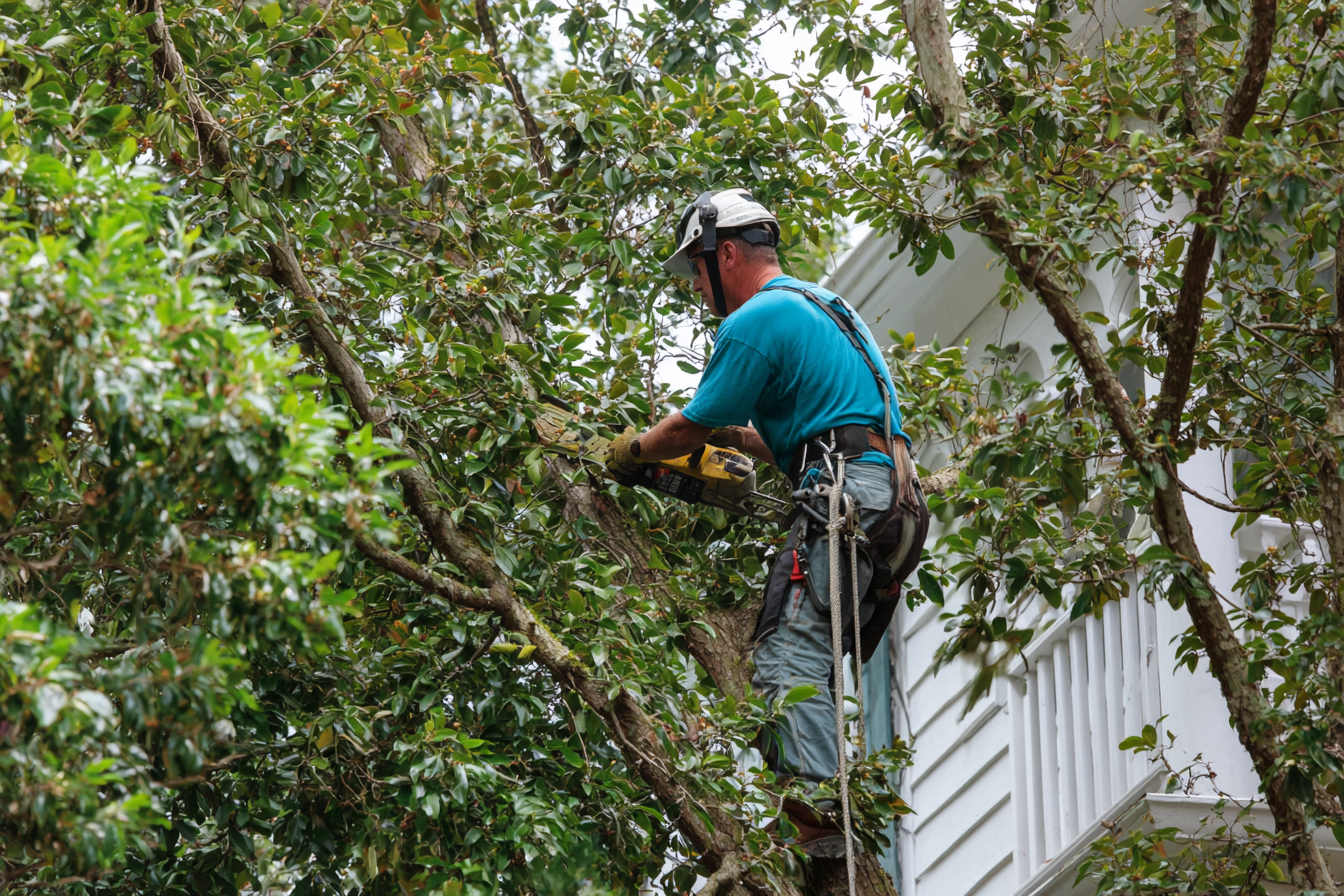
Did you know that the trees on your property are one of the most powerful and often-overlooked investments you can make in your home's value? Healthy, mature trees don't just add a touch of natural beauty; they are literally money growing in your yard. Research from organizations like the Arbor Day Foundation and the USDA Forest Service consistently shows that well-maintained trees can increase a property's value by anywhere from 6% to an impressive 15%.
Trees create an established, inviting atmosphere and offer a host of tangible benefits that modern buyers are looking for. However, unkempt or diseased trees can quickly become a liability, reducing your home's appeal and creating safety risks. This is where professional tree trimming becomes the critical link, transforming a potential problem into a proven asset. Regular, strategic tree trimming is the key to unlocking and maximizing the financial and aesthetic potential of your entire landscape.
How Does Tree Trimming Directly Enhance Curb Appeal?
Curb appeal is the crucial first impression your home makes, and it's the single biggest factor influencing a buyer's initial interest and perceived value. Think of tree trimming as giving your landscape a professional, polished haircut that instantly elevates its look.
- Creates a Tidy, Maintained Look: When branches are overgrown, dead, or crossing, they make the property look neglected and messy. Professional trimming removes this unsightly clutter, resulting in a clean, crisp, and well-kept appearance. A tidy yard signals to potential buyers that the home has been meticulously cared for, extending its perceived value.
- Frames the Home's Architecture: Properly trimmed trees are shaped to complement, not obstruct, the view of your house. They act like natural, living picture frames, drawing the eye toward the home's best architectural features. Overgrown trees can shroud your house in shadow, making it look smaller and hiding key elements that should be highlighted.
- Promotes Optimal Light and Space: Trimming, especially "lifting" the lower canopy or "thinning" the crown, allows more sunlight to penetrate the lawn and reach the home. This brightens your outdoor living spaces and ensures your lawn and gardens thrive, which are major selling points for homebuyers. It also prevents the property from feeling closed-in or dark, making the yard feel more spacious and welcoming.
Why Is Tree Health a Factor in Property Valuation?
The health and longevity of your trees are not just environmental concerns; they are long-term financial considerations for a potential buyer. A dying tree is a significant future expense (removal cost), but a healthy tree is a long-term benefit.
- Prevents Disease and Pest Spread: Trimming is a preventative health measure, like a vaccine for your trees. Dead, diseased, or damaged branches are entry points for pests and fungal infections, which can quickly spread to the rest of the tree. Removing these problem areas isolates the infection, preventing a complete loss of the tree.
- Encourages Stronger Structural Growth: When a tree's crown is too dense, it creates weak, competing branches and limits airflow. Strategic pruning encourages better branch spacing and promotes a strong, central leader and overall robust structure. This resilience means the tree is better equipped to withstand high winds, heavy snow, and harsh weather.
- Extends the Tree's Lifespan: By focusing the tree's energy on healthy, viable limbs and removing unnecessary stressors, trimming significantly contributes to its overall vitality. Since mature, healthy trees carry the highest value premium (sometimes adding thousands of dollars to the sale price), ensuring their long-term health is one of the most profitable actions you can take.
How Does Professional Trimming Reduce Safety Hazards and Liability?
A safe property is an appealing property, and safety risks translate directly into a reduction in perceived value and an increase in buyer hesitation. Tree safety is a paramount concern for realtors and inspectors alike.
- Eliminates Falling Limb Risk: Dead or compromised branches are ticking time bombs, especially during a severe Georgia storm. Professional tree trimming identifies and removes these hazardous branches before they have a chance to fall on your home, car, or a person. This proactive removal dramatically reduces the risk of property damage and personal injury.
- Mitigates Structural Conflicts: Overgrown limbs can rub against your roof, chimney, or gutters, leading to costly damage over time, such as shingles being torn or water pooling. Trimming ensures a safe distance between your tree canopy and your home's structure. It also prevents branches from interfering with utility lines, which is a major red flag for home inspectors.
- Enhances Walkway and Driveway Safety: Low-hanging branches that obstruct visibility or force people to duck can be annoying at best and a tripping hazard at worst. Pruning the lower limbs, a process known as "crown raising," ensures clear, safe passage on all sidewalks, driveways, and pedestrian areas. This attention to detail reflects a well-cared-for home.
Can Tree Trimming Help Lower Energy Costs?
Yes, strategically maintained trees play a dual role in energy efficiency, making your home more attractive to buyers looking for long-term savings. The placement of a tree, combined with proper trimming, directly impacts the amount of solar radiation that hits your home.
- Optimizes Summer Shade: Trees positioned on the west and east sides of your home provide critical shade against the intense summer sun. Trimming ensures the canopy is dense enough to block the sun's rays but is shaped to maximize the shading effect on your roof and walls. The U.S. Forest Service states that strategic tree placement and maintenance can reduce summer cooling costs by up to 12%.
- Allows Winter Sun Penetration: In the winter, you want the sun's warmth to hit your home. Deciduous trees, which lose their leaves, are essential here. Trimming them during the dormant season (late winter/early spring) maintains their overall structure while ensuring they drop their leaves effectively. This process allows the bare branches to let the maximum amount of sunlight through, naturally warming your home and reducing heating bills.
What is the Difference Between Tree Trimming and Tree Pruning?
While the terms are often used interchangeably, there is a technical distinction that explains the value of professional service. Both are essential maintenance practices, but they have different primary goals.
Tree Trimming
The primary goal of trimming is aesthetics and obstruction control. Trimming involves removing overgrown or errant branches that affect the tree's overall shape, the clearance around structures, or the proximity to utility lines. The focus is on shaping the tree to enhance curb appeal, clear utility lines, and ensure property safety.
Tree Pruning
The primary goal of pruning is health and structural integrity. Pruning involves removing specific parts of the tree, such as dead, diseased, weak, non-productive, or crossing branches and stems. The focus here is on improving the tree's long-term health, increasing its strength, extending its lifespan, preventing disease, and promoting potential fruit or flower production.
A professional arborist from Georgia Pro Tree Services performs both trimming and pruning as part of a comprehensive service. They assess the specific needs of each tree on your property to ensure a balanced, healthy outcome. They use proper techniques—like making cuts at the branch collar—to promote quick healing and prevent decay.
When is the Best Time to Trim Trees for Maximum Property Value?
Timing is crucial when it comes to tree care. Trimming at the wrong time of year can stress or damage a tree, undoing your investment. For the greatest impact on tree health and, consequently, your property value, you should follow seasonal guidelines.
- Late Winter to Early Spring (Dormant Season): This is the ideal time for most deciduous trees (leaf-bearing trees) in Georgia. The lack of leaves allows the arborist to clearly see the tree's structure and identify all dead or crossing branches. The tree is dormant, meaning the pruning causes minimal stress, and the wounds heal quickly once the active growing season begins.
- After Flowering (for Spring Bloomers): Trees and shrubs that flower early, such as Dogwoods or Magnolias, should be trimmed immediately after their blooms fade. Pruning these trees later in the year will remove the buds for next year's flowers, reducing their aesthetic value.
- Year-Round for Safety: Any branch that is dead, diseased, or poses an immediate safety hazard (like storm damage) should be removed immediately, regardless of the season. Prioritizing safety is always a wise investment.
Conclusion: Your Tree Trimming Investment
Investing in professional tree trimming is one of the most cost-effective ways to enhance your property's market appeal and secure a higher return on your home investment. It’s more than just aesthetics; it's a critical strategy that intertwines safety, tree health, and energy efficiency into one service. By keeping your trees perfectly shaped, structurally sound, and free of hazards, you are actively increasing the intrinsic and financial value of your entire property.
Ready to transform your landscape and maximize your home's value?
Contact Georgia Pro Tree Services today for a professional consultation and a free estimate on expert tree trimming and pruning!
FAQ: Tree Trimming and Property Value
Does tree trimming always increase property value?
Yes, proper and strategic tree trimming almost always contributes positively to property value. The key word is proper. Professional trimming enhances curb appeal, which is critical for first impressions, and eliminates safety hazards and liability risks, which prevents buyer hesitation. Furthermore, it improves the long-term health and structure of the tree, ensuring that this living asset continues to provide benefits like shade and aesthetic beauty for years to come. In contrast, poorly executed trimming, such as "topping" a tree, can cause irreversible damage, stress the tree, and actually reduce property value by creating an unattractive, unhealthy structure.
How much value can well-maintained trees add to a home?
Well-maintained, healthy, mature trees can add significant financial value, typically ranging from 6% to 15% to the overall property value. The exact figure depends on the size, species, and location of the trees, as well as the local real estate market. In some high-value areas, studies have shown that a single mature tree in the front yard can increase the sales price by an average of over $7,000. For potential buyers, a thriving, well-structured landscape signals good stewardship, which translates into a higher offer price and a quicker sale time.
Why is it better to hire a professional arborist instead of doing it myself?
Hiring a Certified Arborist from a professional service like Georgia Pro Tree Services is essential for maximizing your return on investment. Arborists are highly trained experts who understand tree biology and make precise cuts that promote healing and proper growth. DIY trimming often results in improper cuts that can leave the tree vulnerable to pests, disease, and decay, potentially leading to the tree's decline or even death. Additionally, professional services have the necessary insurance and specialized equipment to safely perform high-access or complex cuts, protecting you from personal injury and liability.
Can overgrown or unmaintained trees hurt my property value?
Absolutely. Overgrown or unmaintained trees can significantly detract from your property value. An unkempt landscape with trees that obscure the home, block light, or have dead/diseased limbs creates a negative impression and raises immediate concerns for buyers. They will factor in the perceived future cost of professional removal and extensive repairs, often leading to lower offers or causing the home to linger on the market. A hazardous tree that poses a risk to the structure or power lines is a serious liability that can be a deal-breaker for a potential purchaser.

We're your local tree pros!
Georgia Pro Tree Services takes the highest quality of care when servicing your trees. Call us to find out how we can help you keep your yard in top shape.



